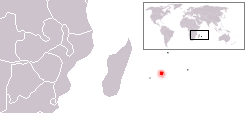| Mauritius olive white-eye | |
|---|---|
 | |
| On Île aux Aigrettes | |
| Scientific classification | |
| Kingdom: | Animalia |
| Phylum: | Chordata |
| Class: | Aves |
| Order: | Passeriformes |
| Family: | Zosteropidae |
| Genus: | Zosterops |
| Species: | Z. chloronothos |
| Binomial name | |
| Zosterops chloronothos (Vieillot, 1817) | |
 | |
| Range highlighted in red | |
| Synonyms | |
Zosterops chloronothus Contents | |
The Mauritius olive white-eye (Zosterops chloronothos, [3] [4] [5] often mistakenly spelled Zosterops chloronothus [6] [7] ) is a very rare and localized passerine from the family of white-eyes (Zosteropidae). It is one of two white-eye species endemic to the island of Mauritius, the other being the Mauritius grey white-eye.




